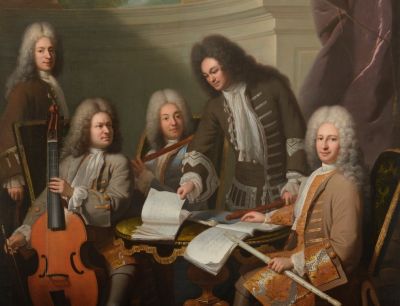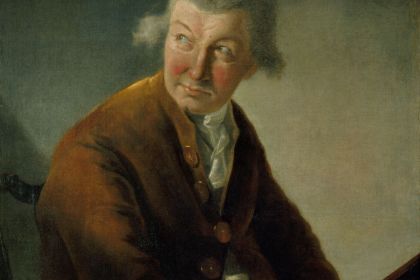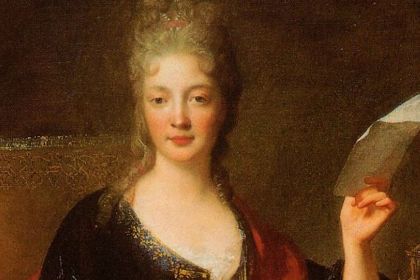FLUTE
The early collaboration of flute and viol in the court of Versailles

The Composer Michel De La Barre Directing Marin Marais and the Ordinary
Flutists of the King's Chamber by André Bouys
Music Period: Baroque
Country: France
Composer: Marin Marais, Michel de la Barre, Jacques-Martin Hotteterre, Anne Danican Philidor
In one of his marvelous court paintings, André Bouys depicts four prominent composers working on a composition for Baroque flute which first came into fashion in France as part of the arrangement within the elegant ornamentation of the Baroque style.
The flute underwent significant changes in the second half of the 17th century when the so-called Renaissance flute could no longer provide the necessary level of virtuosity for the more complicated music of the Baroque era. The Baroque flute or traverso was made of several sections with conical bore design which gave the new instrument the improved intonation and allowed the increase of volume in the lowest notes. This flute became a completely chromatic device which was more suitable for the role of the solo instrument not only in chamber music but also in large orchestras.
In Bouys' painting, Jacques Hotteterre is shown on the right wearing a brocade jacket and holding an expensive ivory flute. The most famous of the Hotteterre dynasty of woodwind-makers, Jacques earned the nickname “le Romain” as a result of his time spent studying in Rome. Aside from performing on various woodwinds, Jacques Hotteterre designed Baroque flutes and also taught playing technique to wealthy amateurs.
Jacques Hotteterre:


In 1707, Hotteterre made history by publishing the first known essay on flute-playing in his work Principes de la flûte traversière which earned a colossal success throughout Europe while undergoing numerous reprints. As a composer, he issued treatises including directions for improvising woodwind preludes as well as a variety of compositions such as duet suites and trio sonatas. He became a musician of the court Louis XIV in the king's Grande Écurie in 1708.
Listen to Jacques Hotteterre's Prélude performed by Wilbert Hazelzet:
Another flute virtuoso and versatile composer Michel de La Barre is depicted in the same painting as standing and wearing a black wig. His vast output of 18 books of flute music between 1694 and 1725 was a vital factor in the emergence of the instrument as one of the most popular of the 18th century. He also was the first person who ever published solo music specifically for flute.
As a musician, Michel de La Barre played at the Académie Royale de Musique (The Paris Opera) and the courts of Louis XIV and Louis XV. The quartet illustrated on this canvas discusses the pieces from de La Barre's Third Book of Trios for the Violins, Flutes, and Oboes mixed with Sonatas for the Transversal Flute which is opened on the chapter of the First Sonata for continuous bass.
Listen to Michel de La Barre's Chaconne from Suite L'Inconnue performed by Robert Stallman:
The third member of the flute group in the painting, dressed in a light blue jerkin with gold braid and holding a boxwood flute, is, most likely, Anne Danican Philidor who was a prominent musician of the renowned family of woodwind players which had been serving at the court since the reign of Louis XIII. Anne is mainly known as the founder of Concert Spirituel—one of the first public concert series in existence.
As a composer, Anne Danican Philidor dedicated his early years to creating several ballets and operas and later, in 1712, published a collection of works for flute.
Listen to Anne Danican Philidor's Sonate pour la flute à bec performed by Frans Brüggen, Anner Bylsma, and Gustav Leonhardt:
One of the most frequently used accompaniments in Baroque music was the bass arpeggio also called figured bass or basso continuo which was performed on keyboards or other bass instruments such as viol, cello, and bassoon. For this purpose, prominent composer Marin Marais, is depicted in the painting with his seven-string bass viol.
Marais, initially known as one of the most talented musicians in France, played in the orchestra of The Paris Opera from 1675. His gift for composition was revealed by the famous maestro Jean-Baptiste Lully who taught Marais musical harmony and counterpoint.
Marin Marais:


Although he composed four operas and a dozen pieces for flute, Marin Marais is primarily appreciated for his more than 600 works for various combinations of viols. The collections which he began publishing from 1692 consist primarily of dances, fantasies, chaconnes, rondeaux, and pièces de caractère.
By the middle of the 18th century, viol—also called viola da gamba—went out of fashion when its functions in the orchestra were replaced by more progressive cello and double bass. In the 20th century, together with the growing interest in early music, the viol was revived by the efforts of enthusiasts and amateurs who sought to get an authentic performance of the Baroque and Renaissance masterpieces.
Listen to Marin Marais' Sarabande a l'Espagnol performed by Jordi Savall on viola da gamba:
The identity of the fifth person in the painting remains a complete mystery, as well as his role in this ensemble. Standing behind Marin Marais, he gazes at the viewer and holds a wooden object in his right hand which seems to be more of a cane than a musical instrument.
The Composer Michel De La Barre Directing Marin Marais and the Ordinary Flutists of the King's Chamber by André Bouys:












Nice story, only...it's NOT Marais on the picture but Antoine Forqueray, and Upon seeing this I wonder how thorough your research is. Marais ; Fake News!
The painting by André Bouys, preserved in three versions, has the title "The Composer Michel De La Barre Directing Marin Marais and the Ordinary Flutists of the King's Chamber".
Here is another work by André Bouys depicting Marin Marais (the resemblance is obvious):
I suppose, wiki contains an incorrect pic by Antoine Forqueray: https://en.wikipedia.org/wiki/Antoine_Forqueray
The painting reproduced above is a copy (by another artist) of a painting, now attributed to Andre Bouys, at the National Gallery in London. I have known this painting, in reproduction, for many years now and have never, until I read the above article, seen it described as: "The Composer Michel De La Barre Directing Marin Marais and the Ordinary Flutists of the King's Chamber". The painting was purchased by the National Gallery in 1907, at which time it was entitled: Les Ordinaires de la Musique du Roi. The title normally used today, and since at least the 1970s, is simply: La Barre and other Musicians. The painting has inspired many attempts to identify the subjects. It is generally accepted that the standing man turning the page of a music book is Michel de la Barre (the book is Michel de la Barre's Livre III, the page, the first of his: Premiere Sonate en trio in G major). The identity of the other sitters is by no means certain. While it is true that Bouys painted a likeness of Marin Marais in 1704, the facial features of Marais, as portrayed by Bouys, bear only a vague similarity to the features of the seated bass violist in the National Gallery painting. The set of the mouth and expression of the eyes are quite different; and it is the opinion of some (including this commentator) that the gambist depicted in, La Barre and other Musicians is Antoine Forquery. The standing man in the background, on the left of the painting, was likely included for artistic purposes - the composition would be unbalanced without him; and could well be a self portrait by Bouys. The corresponding figure in the painting reproduced above is clearly a different man - but that's by the by.
"Add a comment" - why? when you obviously can't be bothered to publish. Presumably you've no answer to the argument set forth in my previous two comments elucidating the good reasons why the gambist in the group portrait reproduced above is far more likely to be Antoine Forqueray than Marin Marais.
Happy days
thank you for your input, I cannot confirm or deny your arguments. here is the source where I got the info:
http://www.alexis-bordes.com/en/worksofart/new-acquisitions/paintings/ar...
thanks a lot!
Serg